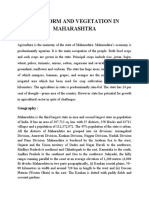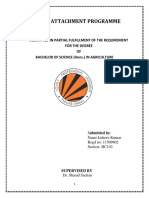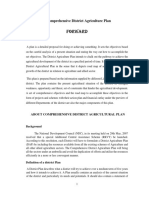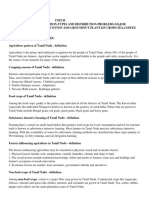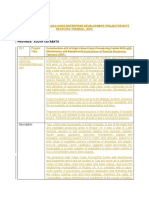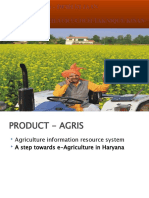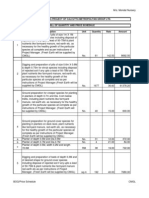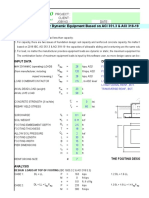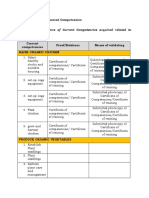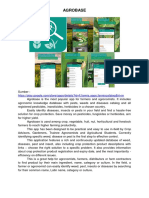0 ratings0% found this document useful (0 votes)
43 viewsAgricultaral Pond
Agricultaral Pond
Uploaded by
Kodi HarikrishnaThis document provides information on horticulture in Andhra Pradesh, India. It discusses the formation and location of the state, describes its climate and existing horticultural status. It then outlines the objectives and strategies of the National Horticulture Mission and State Horticulture Mission in Andhra Pradesh. Key activities supported include establishing model nurseries and new gardens/expanding area under various crops like sweet orange, mango, papaya and flowers using drip irrigation systems. The goal is to holistically promote horticulture production, post-harvest, processing and marketing in the state.
Copyright:
© All Rights Reserved
Available Formats
Download as PDF, TXT or read online from Scribd
Agricultaral Pond
Agricultaral Pond
Uploaded by
Kodi Harikrishna0 ratings0% found this document useful (0 votes)
43 views39 pagesThis document provides information on horticulture in Andhra Pradesh, India. It discusses the formation and location of the state, describes its climate and existing horticultural status. It then outlines the objectives and strategies of the National Horticulture Mission and State Horticulture Mission in Andhra Pradesh. Key activities supported include establishing model nurseries and new gardens/expanding area under various crops like sweet orange, mango, papaya and flowers using drip irrigation systems. The goal is to holistically promote horticulture production, post-harvest, processing and marketing in the state.
Original Description:
agricultural
Copyright
© © All Rights Reserved
Available Formats
PDF, TXT or read online from Scribd
Share this document
Did you find this document useful?
Is this content inappropriate?
This document provides information on horticulture in Andhra Pradesh, India. It discusses the formation and location of the state, describes its climate and existing horticultural status. It then outlines the objectives and strategies of the National Horticulture Mission and State Horticulture Mission in Andhra Pradesh. Key activities supported include establishing model nurseries and new gardens/expanding area under various crops like sweet orange, mango, papaya and flowers using drip irrigation systems. The goal is to holistically promote horticulture production, post-harvest, processing and marketing in the state.
Copyright:
© All Rights Reserved
Available Formats
Download as PDF, TXT or read online from Scribd
Download as pdf or txt
0 ratings0% found this document useful (0 votes)
43 views39 pagesAgricultaral Pond
Agricultaral Pond
Uploaded by
Kodi HarikrishnaThis document provides information on horticulture in Andhra Pradesh, India. It discusses the formation and location of the state, describes its climate and existing horticultural status. It then outlines the objectives and strategies of the National Horticulture Mission and State Horticulture Mission in Andhra Pradesh. Key activities supported include establishing model nurseries and new gardens/expanding area under various crops like sweet orange, mango, papaya and flowers using drip irrigation systems. The goal is to holistically promote horticulture production, post-harvest, processing and marketing in the state.
Copyright:
© All Rights Reserved
Available Formats
Download as PDF, TXT or read online from Scribd
Download as pdf or txt
You are on page 1of 39
IN FULL BLOOM
NATIONAL HORTICULTURE MISSION
in
ANDHRA PRADESH
ANDHRA PRADESH
Formation of the State:
The state of Andhra Pradesh was formed in the year 1953
separating certain districts from the erstwhile composite
Madras state, with State Capital at Kurnool.Later with the
sacrifice made by "Amarjyothi" Sri.Potti Sreeramulu the state
of Andhra Pradesh was created with effect from 1.11.1956
duly emerging the Telangana districts situated in the deccan
plateau and delineating Bellary area to merge with Karnataka
state. The final shape of the state comprised of 9 coastal
districts, 4 Rayalaseema and 9 Telangana districts.
Location:
The state of Andhra Pradesh is situated on the globe in the tropical region between 12014' and
19054' North latitudes and 76046' and 84050' East longitudes. It is bounded on the North by
Maharashtra, on the North-East by Orissa and Madhya Pradesh, on the East by Bay of Bengal, on the
South by Tamilnadu and on the West by Karnataka States. The state has a long coastal line extending
over 960 km from Ichapuram sands in Srikakulam district to Pulicat lake in Nellore district.Andhra
Pradesh is the 5th largest state in the Indian Union both in terms of geographical area and population
comprising of 23 districts 1,105 revenue mandals, 29,994 villages spreading over 2,76,814 sq.km.
Climate:
The state has a tropical climate with moderate diffusion to subtropical weather. Humid to semi-humid
conditions prevail in the coastal area while arid to semiarid situations pronounce in the interior parts
of the state, particularly Rayalaseema and some districts of Telangana. The areas covered by Deccan
Plateau are characterized by hot summers with relatively pleasant winters.
Horticulture Status:
Area under Horticulture crops during 1982 was recorded as 3.7 Lakh Hac. in 2001 13.78 Lakh Hac was
recorded with an annual production of 9.5 M.Ts, in 2002 1.5 Million Hac with an annual production of
10.00 M.Ts, in 2003-04 Area was recorded as 1.6 Million Hac with an annual production of 11.8 M.Ts,
in 2004-05 the area is about 15.79 Lakh Hectares with production of 128 Lakh M.Ts and in 2006-07
the area is about 17.85 Lakh Hectares with production of 163.6 Lakh M.Ts.
Andhra Pradesh is the leader in Production of Citrus, Chillies, Turmeric and Oil Palm and also major
producer of Cocoa, Cashew, Guava, Coriander, Banana, Ginger and Coconut.
Agro-Climatic Zones :
The cropped area in Andhra Pradesh is divided into seven zones based on the Agri-climatic conditions.
The classification mainly concentrates on the range of rainfall received, type and topography of the
soils. The districts covered by the different zones and their Agri-climatic characteristics are given
below:
Krishna and Godavari Basin
North Coastal Zone
North Telangana Zone
Southern Telangana Zone
Southern zone
High Altitude & Tribal Areas
Scarce rainfall zone
About NHM (National Horticulture Mission)
National Horticulture Mission has been launched as a Centrally Sponsored Scheme to promote holistic
growth of the horticulture sector through an area based regionally differentiated strategies. The
scheme will be fully funded by the Government and different components proposed for
implementation financially supported on the scales laid down.
STRATEGIES
To achieve the objectives of the National Horticulture Mission, the mission would adopt the
following strategies.
Ensure an endto-end holistic approach covering production, post harvest management,
processing and marketing to assure appropriate returns to growers /producers.
Promote R&D technologies for production, post-harvest management and processing.
Enhance acreage, coverage, and productivity through; a)Diversification, from traditional crops
to plantations, orchards, vineyards, flower and vegetable gardens ; b)Extension of appropriate
technology to the farmers for high-tech horticulture cultivation and precision farming.
Assist setting up post harvest facilities such as pack house, ripening chamber, cold storages,
Controlled Atmosphere (CA) storages etc, processing units for value addition and marketing
infrastructure.
Adopt a coordinated approach and promotion of partnership, convergence and synergy
among R&D, processing and marketing agencies in public as well as private sectors, at the
National, Regional, State and Sub-State levels.
Where appropriate and feasible, promote National Dairy Development Board (NDDB) model of
cooperatives to ensure support and adequate returns to farmers,
Promote capacity-building and Human Resource Development at all levels.
STATE HORTICULTURE MISSION
State Horticulture Mission has been launched in Andhra Pradesh in the year 2005 to promote
holistic growth of the horticulture sector through an area based regionally differentiated
strategies. This programme is under implementation in 18 districts, Srikakulam, West
Godavari, Guntur, Prakasam, Nellore, Chittoor, Kadapa, Ananathapur, Kurnool,
Mahabubnagar, Rangareddy, Medak, Nizamabad, Karimnagar, Warangal, Khammam,
Adilabad, Nalgonda and 2 Tribal Areas (Rampachodavaram of East Godavari and Paderu of
Visakhapatnam) of the state.
OBJECTIVES OF SHM
To provide holistic growth in horticulture through research, technology promotion, extension,
processing and marketing.
To enhance the horticulture production to the level of 300 million tonnes by 2011-12.
To establish convergence and synergy among various on-going and planned programs in the
field of horticulture development.
To promote the development and dissemination of technologies by blending traditional
wisdom and frontier knowledge.
To convert waste lands for producing fruits and vegetables.
To plug wastages of horticulture produce.
To create facilities for marketing & processing.
SHM STRATEGIES
End-to-end approach covering production, post harvest management, processing and
marketing
Promote Research and Development (R&D) of technologies for production, post-harvest
management and processing.
Enhance acreage of cultivation as well as productivity through diversification from traditional
crops and adopting cluster approach for suitable crops / plantations.
Adoption of measures to improve availability of quality seeds / saplings, fertilizers and
pesticides.
Extension of appropriate technology to the farmers including high tech horticulture and
precision farming.
Improved irrigation, particularly micro irrigation.
Improving post harvest management, processing for value addition and marketing
infrastructure.
Coordinated approach and promote partnership, convergence and synergy among
R&D,processing and marketing agencies in public as well as private sectors.
Promoting NDDB model of cooperative approach to ensure support and adequate returns to
farmers.
Strengthening capacity building and Human Resource Development at all levels.
COMPONENTS OF NATIONAL HORTICULTURE MISSION
Plantation Infrastructure & Development
Production of planting material
Establishment of new gardens
Rejuvenation/ replacement of senile plantation
Creation of water resources sources
Protected Cultivation
Promotion of INM/IPM
Organic Farming
HRD
Technology dissemination through demonstration/Front line demonstration
Post Harvest Management
Processing & Value Addition
PLANTATION INFRASTRUCTURE & DEVELOPMENT
State Horticulture Mission of Andhra Pradesh has provided assistance to 34 Model Nurseries in Public
Sector and 35 Model Nurseries in Private Sector with a financial assistance of Rs.317.74 lakhs and
Rs.34.91 lakhs respectively. Small Nurseries were also assisted in both Public & Private Sectors with a
financial assistance of Rs.49.50 lakhs & Rs.18.00 lakhs respectively from 2005-06 to 2008-09.
SMALL NURSERY ANANTAPUR DIST.
MODEL NURSERY CHENGICHERLA, ANANTAPUR DIST.
MODEL NURSERY GOPANNAPALEM (W. GODAVARI)
SMALL NURSERY INSPECTION OF TECHNICAL SUPPORT GROUP MEMBER & DEPT. OFFICERS IN ANANTAPUR DIST.
ESTABLISHMENT OF NEW GARDENS / AREA EXPANSION:
SWEET ORANGE
Sweet Orange and Acid Lime are the predominant citrus species grown in A.P. Area under
Sweet Orange is more in arid scarce rainfall areas compared to Acid Lime grown in humid tracts.
Ananthapur district with least rainfall in southern part of India grows 21000 ha of Citrus crops,
predominantly Sweet Orange. Kadapa district was famous for Cheeni Orange (Sweet Orange) during
the first half of 20th century. The district now has only about 3500 ha of Sweet Orange and about 500
ha of Acid Lime. Kurnool district has the least area of about 1900 ha under Sweet Orange and about
100 ha under Acid Lime. For the Groundnut district Ananthapur, Sweet Orange provides the
financial support. In A.P., Ananthapur is the second largest Citrus growing district after Nalgonda,
another drought hit district in Telangana with fluoride contaminated ground water. Prakasam another
partially drought prone district with the problem of fluoride in ground water is also emerging as an
important Citrus belt with 19000 ha under Sweet Orange. Dry climate with low rainfall and deep
under ground water favour this crop in these districts. Incidentally Sweet Orange is coming up well in
the fluoride ridden districts.
AREA EXPANSION PROGRAMME MANGO GARDEN
AREA EXPANSION PROGRAMME - SWEET ORANGE GARDEN WITH DRIP NALGONDA DIST.
AREA EXPANSION PROGRAMME PAPAYA WITH DRIP ANANTAPUR DIST.
AREA EXPANSION PROGRAMME LOOSE FLOWER CULTIVATION KADAPA DIST.
With the launch of National Horticulture Mission in the State the following perennial crops &
non-perennial crops were taken under Establishment of New Gardens for expansion:
PERENNIAL CROPS:
Mango 38,732 Ha. with a financial assistance of Rs.3,758.60 lakhs.
Sweet Orange 57,408 Ha. with a financial assistance of Rs.6,153.78 lakhs.
Sapota gardens 2,424 Ha. with a financial assistance of Rs.120.88 lakhs.
Pomegranate 1 ,862 Ha. with a financial assistance of Rs.151.67 lakhs.
Guava 349 Ha. with a financial assistance of Rs.35.92 lakhs
Acid Lime 2,281 Ha. with a financial assistance of Rs.192.62 lakhs.
SUCCESS STORY OF AREA EXPANSION OF POMEGRANATE
A. Farmers profile:
Name : A. Siva Prasad & others.
Village : Thippaipally
Survey No : 62,68
Extent : 25.00 Acs.
Mandal : Orvakal
District : Kurnool.
B. Baseline data:
Which were the crops grown earlier : Field crops like Bengal
gram, maize, ground nut etc
were grown earlier
What were the practices followed earlier in terms of :
Training and pruning : Since the crop is grown for the
Manuring : 1
st
time the farmers has got
Irrigation : no knowledge of training &
Plant Protection : pruning usage of fertilizers,
Crop management : Harvesting / Packing, irrigation,
Marketing : plant Protection aspects,crop
Marketing etc.
Annual expenditure : Rs.2,15,000/- Approx.
Monetary returns in the past : Rs.4,90,000/- Approx.
C. Case study and statement of facts:
New changes / intervention through SHM :
1. Commercially profitable crop like pomegranate was recommended.
2. Pomegranate crop requires prcised training and pruning for increase in yields and
accordingly the farmer was trained in these aspects.
3. As the quality of the produce largely depends on efficient fertilizer use more so for
good keeping quality and color development, organic manures including
vermicompost and oil cakes were extensively used. In this regard a vermicompost
unit has also been constructed..
4. As the major problem in pomegranate cultivation is fruit fly &fruit rot, these were
effectively put under control by prophylactic measures of keeping plant as well as
pruning instruments sanitized with the usage of bio pesticides & fungicides.
5. As this is a high income giving crop, the pruning and general crop management is
thus followed so as to coincide the harvesting period with high prices.
6. Irrigation and fertigation are being done invariably though drip systems.
7. Harvesting of the produce and post harvest handling is done in plastic crates.
The crops responses :
1. Due to timely training & pruning, the plant has put forth vigorous and healthy flush
and floral buds leading to qualitative & quantitative fruit development.
2. J udicious use of organic manure including vermicompost and organic concentrates
like oil cakes along with inorganic fertilizers though fertigation has improved the
size of fruit, color development and keeping quantity of fruit.
3. Irrigation though drip system has the tremendous effect on fruit development as the
fruit cracking is relatively negligible, because the supply of water has been equated
with the crop demand.
Present Annual expenditure and : 12,50,000/- approx.
Returns : 35,00,000/- approx.
Investments / subsidies:
The intervention of subsidy component has encouraged the farmer to meet the
expenditures of different over heads and certain unforeseen expenses. The supply of inputs
ie., plant protection chemicals, fertilizers was very timely and its usage very effective.
SUCCESS STORY OF TISSUE CULTURE BANANA
A. Farmers profile:
Name : D.Chinna Mabu, S/o. Pedda Hussain Saheb
Village : Alinagaram(H), Bukkapuram(v).
Survey No : 214,212,219
Mandal : Mahanandi
District : Kurnool
B. Baseline data:
1. Crop grown earlier is Banana (pedda patchha arati) Robusta.
If the same crop as of now is grown :-
1. The same crop is being grown but with a different variety G9 tissue cultured plants.
The planting material is obtained from private firms and departmental laboratories
(Bio technology laboratory).
2. In majority of the cases the planting material used was suckers brought from
Tamilnadu.
3. The application of manures and fertilizers was done manually by digging a hole
near the plant and channel irrigating the crop as and when required.
4. In the case of plant protection no scheduled was followed, however application of
Thimmet granules @ 15 gms/tree were applied 2 times one at 90 DAP another at
180 DAP to avoid soil insects.
AREA EXPANSION PROGRAMME BANANA WITH DRIP.
5. The plantation was raised through suckers and the time required to reach maturity
is nearly 12 months, it requires the external support to avoid tilting due to heavy
bunch weight in the event of winds and gales.
6. Normally, the bunches after attaining maturity turn to pale green colour, are
harvested and are sold in the local market or they are send to nearby adjoining
districts.
Annual expenditure : Rs.40,00045000/- per ac
Monetary returns in the past : Rs. 80000-85000/- per ac
C. Case study and statement of facts:
New changes / intervention through SHM :
1. The farmer has switched over from Robusta (sucker) to G.9 tissue culture plants
because the entire plantation reaches maturity 2 months earlier without requiring
any external support.
2. The bunch weight of Robusta is only 20-25kg. where as the tissue culture
banana(G.9) is 30-35 kg.
3. In tissue culture banana plants it is possible to grow 3-4 ratoon crop where as with
the suckers only 2 ratoon can be taken.
4. Earlier only 1200 no. of plants per acre were grown at spacing of 6x6 but high
density plantation is also tested and adopted at spacing of 6x5 with 1450 no.of
plants per acre.
5. Culling out of extra suckers was done by digging out the sucker from soil and the
entire root system used to get damaged but now that the farmer is just cutting the
sucker at ground level without causing any damage to the root system.
6. Now that the farmer is following the correct fertilizer schedule and is being done by
fertigation.
7. The spraying schedule is being followed as the prophylactic measure.
8. Mulching is also practiced as it reduces weed growth and soil borne diseases and
the farmer has also observed less incidence of sigatoka disease.
9. The vermicompost and neem cake are also widely used and believed to have
reduced the leaf sport and sigatoka disease.
10. The plantation is generally done in two seasons namely J anuary and J une keeping
in view of the remunerative price in the months of October and March respectively.
Present Annual expenditure : Rs. 60,000/- approx
Present Annual returns : Rs. 1,70,000/- approx
REJ UVENATION
MANGO
Even in the scarce rainfall zone Mango is mostly rain fed. However the area is limited to 6500
hectares (ha.) in Ananthapur and 4200 ha. in Kurnool. In the southern part of Kadapa the rainfall is
slightly high and Mango is the major fruit crop extending to 18000 ha. In the Mango belt of these
three districts Baneshan is the predominant Table variety followed by Thotapuri, Neelam and
Neleshan, besides a few juicy varieties. Mangoes are grown mostly on red loamy soils with medium
water holding capacity. Atmospheric humidity during the bearing period is low. Fruit quality and shelf
life of mangoes grown in this tract are better than those grown the coastal districts of the state. The
yields, however, are lower in view of drought situations prevailing in these districts.
State Horticulture Mission has induced the farmers to go in for Drip irrigation and Fertigation
in the young orchards and rejuvenation of aged gardens of poor productivity to improve their yields.
Orchard management practices were followed with the assistance received from SHM in many
gardens. This strategy has worked well and productivity has increased from 30 to 50 percent in
majority of the gardens. Adoption of new technology resulted in increasing the quality of the fruits
and the income of the farmers.
Rejuvenated old orchards which produced higher yields and net returns
SUCCESS STORIES OF THREE FARMERS FROM KADAPA DISTRICT ARE
SUMMARIZED BELOW
(1) (2) (3)
Farmer P.Y. Narasimha Reddy M.Rajamma B.Govind Naik
Village Yendapally Mudumpadu Malluru
Mandal Raychoti T.Sundupalli Chinamandem
District Kadapa Kadapa Kadapa
Extent 1 ha. 1 ha. 1 ha.
Age of garden 20 years 20 yrs 30 yrs
Previous Traditional Traditional Traditional
Practices rain fed orchard rain fed orchard rain fed orchard
New Technologies Followed
1. Pruning of dried twigs, opening of the top, cutting of disease effected
branches and unwanted branches.
2. Ploughing of the garden
3. Preparation of basins and application of fertilizers 100 kg DAP, 50 Kg
Urea and 250 kg. potash.
4. Spraying of 3 Kg. AP Formula-4.
Previous yields
(tons/acre) 7.2 tons 6 tons 6.8tons
Gross returns
Per acre(Rs)
28,890 24,000 26,780
Net returns
Per acre(Rs) 18,000 16,000 19,200
Present yields
(tons/acre) 10 8.8 9.6
Gross returns
per acre(Rs) 50,000 44,000 48,000
Net returns
per acre(Rs) 36,000 32,000 36,000
REJ UVENATION OF MANGO GARDEN UNDER THE GUIDANCE OF TSG
MEMBER
REJUVENATION CASHEW
in Srikakulam District
Cashew one of the major horticulture crops grown in Srikakulam District with an extent of
19268 Ha with a productivity of 0.599 M.Tons per Ha. In Srikakulam District most of the cashew
gardens are seedling origin and are grown as rain fed with poor maintenance.
In Srikakulam District 80% of the Cashew gardens are more than 15 years old and most of the
gardens are severely affected with Cashew Root and Stem borer and tea mosquito resulted in less
productivity. With a view to improve the productivity it is proposed to take up rejuvenation by
removing and replacing the old, senile and severely pest affected cashew trees with high yielding
varieties by following proper canopy management as well as nutrient, pest and disease management.
During 2006-07, 1500 Ha. of Cashew gardens were rejuvenated with the assistance of State
Horticulture Mission both in plain and tribal areas.
REJUVENATION PROGRAMME ACHIEVEMENT (FROM 2005-06 to 2008-09)
FARM PONDS
Farm ponds are manmade tanks constructed for holding the water which could be
used during scarce season for the uninterrupted physiological activities of the crops.
It is constructed by excavating the soil, by depositing the soil on the bunds and by
laying a Geo-Membrane HDPE sheet in the excavated tank for preventing the infiltration and
seepage.
The water from bore wells, canals during the rainy seasons can be stored in these
ponds and which can be used during scarce season.
Significant progress has been achieved in this component during 2009-10.
Overwhelming response was received from 7 districts i.e.., Kadapa, Ananthapur, Kurnool,
Chittoor, Prakasam, Nalgonda and Mahabubnagar where the availability of water is not
continuous throughout the year and the yield of water depletes during summer months.
500 No. of Farm Ponds of 5 types of standard sized i.e., 10 (14 x 14 x 4m),
20(21 x 21 x 4m),30(27 x 27 x 4m),40(31 x 31 x 4 m) & 50(35 x 35 x 4m) lakh liters ponds for
irrigating 1,2,3,4 & 5 Ha. of crops respectively were constructed to provide water facility for
crops like Mango, Sweet Orange during crucial period and also to facilitate raising of irrigated
dry crops.
Sri. A. Indrasena Reddy, Uppunuthala Mandal, Mahabubnagar Dist.
Pond Size 21 x 21 x 4 Mtrs.
Sri. Ramchandraiah, Veldanda Mandal, Mahabubnagar Dist.
Pond Size 21 x 21 x 4 Mtrs.
FARMPOND OF SRI.NARAYANA-(ST FARMER) AMMARIVARI PETA, BOKKA RAYA SAMUDRAM
SUCCESS STORIES
Name of the Beneficiaries:T.Saidulu goud/Thandu Sridevi and others
Village Cheruvupalli
Mandal Thipparthi
District Nalgonda
Farmpond capacity 50 lakhs litres
Before construction of farm pond: Ground water depletion and inadequate water
availability led to drying up of Citrus plants.
After construction of farmpond: The farmpond has been stored with 50 lakhs litres
of water in the pond to provide life saving irrigation during April- May months.
PROTECTED CULTIVATION
Green Houses: A Greenhouse is a framed or inflated structure covered with a
transparent or translucent material in which crops could be grown under the
conditions of at least partially controlled environment for the best growth of plants to
achieve maximum yield and superior quality.
Achievement: Since inception of State Horticulture Mission , 30 Green Houses
have been established in different districts of Andhra Pradesh.
Present Practices: Vegetables are being cultivated especially during summer
season. Cut flowers like Gerberas, Carnation are being taken up in 1000 sq mt /
560 sqmt Green Houses. SHM is providing 50% subsidy subject to a maximum of
Rs.325/ sq.mt limited to 1000 sq.mt per beneficiary
Experience: High profitability due to off season cultivation of vegetables. Cut
flowers fetch high market value due to the increased quality as they are grown in
controlled conditions.
Shade Nets: Shade net is a structure enclosed by agro nets or any other woven
material to allow required sunlight, moisture and air to pass through the gaps. It
creates an appropriate micro climate conducive to the plant growth.
Achievement: An area of 627 ha is covered under shade net houses in Andhra
Pradesh
Present Practices: Raising of seedlings in the shade houses is a regular practice.
Apart from that vegetables are also being cultivated in the shade SHM is
providing 50% subsidy subject to a maximum of Rs.7/ sq.mt limited to 2ha per
beneficiary.
Experience: Disease free seedlings can be produced. Seedlings are grown before
hand by the farmers and are being sown in the field to capture early market.
Mulching: Mulches are materials placed over the soil surface to maintain moisture and
improve soil conditions. Mulch can reduce water loss from the soil, minimize weed
competition, and improve soil structure. Properly applied, mulch can give landscapes a
handsome, well-groomed appearance.
Achievement: An area of 80,000 sq.mt is brought under mulching for conserving
soil moisture, controlling weeds, etc
Present Practices: The present practice followed in mulching is the use of plastic
mulch. Assistance up to 50% of the total cost subject to a max of Rs 7000/ha
limited to 2ha per beneficiary.
Experience: 1.Found economical
2.As weeding has become drudgery in cultivation, use of
mulch had served farmers when there was shortage of
labour.
IPM / INM
In Nalgonda District Sweet Orange is the main crop under cultivation occupying an
area of 81583 Ha. Nalgonda is predominantly having Red (44%) and Chalka Soils (47%) with
calcium traces, most of the gardens in pre-bearing and bearing condition exhibit multi-
micronutrient deficiencies like Zinc, Iron, Manganese. With this micro-nutrient deficiency the
plants become pale yellow and unable to synthesis the food and become weak which result in
creating favourable situation for attack of various pest and diseases like dry root rot,
gummosis, canker, mangu-mite attack etc. Dry root and mangu-mite are very serious and
predominant in Nalgonda District
DRY ROOT ROT:
It is caused by fungi
species called Fusarium,
Macrophomina and Diplodia. In
affected trees, the roots get
rottened. Further these trees
exhibits wilting even after
sufficient irrigation. The affected
trees also flower and fruit
heavily. This is one of the
important symptoms of dry root
rot. In advanced situation, the tree dries off.
MANGU-MITE:
This is caused by mites. These mites attack small fruits and suck the juice, so that the rind
becomes purple in color. The Mangu affected fruits are small in size with hard purple color
rind. These fruits do not fetch good price in markets rendering farmers realize less returns.
IMPLEMENTATION: Considering this critical situation for sustainability of Sweet Orange
cultivation in Nalgonda District, INM/IPM component was implemented in 9056 Ha. by
providing required inputs on 50% assistance not exceeding Rs.1,000/- per Hac. under INM
farmers were supplied with AP Formula 4 & 7 for foliar as well as soil application for
correcting multi micro nutrient deficiencies as these micro nutrients play vital role in
photosynthesis, flowering and fruiting.
Under IPM, the following inputs are supplied to farmers on 50% assistance limited to
Rs.1,000/- per ha..
Dry root rot : Carbendizam, Trichoderma Viridae and Pseudomonas
Mangu-mite : O-mite, Ethion and Diphenthiron
The farmers were motivated to use the above inputs for containing dry rot and mangu-
mite, so that the orchards affected with dry root rot are given treatment with fungicides
supplied under the scheme and saved their plants from drying off. The inputs supplied under
dry root rot i.e. carbendizam helped in reducing the microbial load in soil that reduced the
incidence of disease and attack of dry root rot. Similarly, Trichoderma Viridae and
pseudomonas (bio-fungicides) are antagonistic to the fungus thereby creating a safe guard
mechanism on plant root. Similarly, the new insecticides (O-mite) supplied to farmers for
controlling mangu-mite helped the farmers to fetch better price in the market as these
insecticide sprays in monthly intervals prevented / reduced the Mangu problem in Sweet
Orange
The proof of this is that one of the farmers, Sri. Madhava Reddy, Pullemla village of
Chandur Mandal, availed this scheme and got better price in market for his produce @
Rs.6000/- to 7000/- per ton against the price of Rs.2500/- to 3000/- per tone for Mangu
affected produce in Hyderabad market.
ORGANIC FARMING VERMICOMPOST UNITS
The main thrust of the programme is to build the capacities of the farmers so as to
reduce their dependence on the chemical inputs and encourage the Bio/organic resources for
growing fruits and vegetables.
Vermicompost units established with the support of National Horticulture Mission are
networked and the production is being tied up with Area Expansion and Rejuvenation
components of State Horticulture Mission in selected districts.
SUCCESS STORIES OF TWO FARMERS FROM PRAKASAM DISTRICT ARE
SUMMARIZED BELOW
(1) (2)
Farmer Sri. Mekala Shankara Rao Sri. J illela Srinivasa Reddy
Village Tokapally Tokapally
Mandal Peddaraveedu Peddaraveedu
District Prakasam Dt. Prakasam Dt.
Extent 5.45 Acres 5 Acres
Age of garden 13 years 12 yrs
Yield* (Before) 5 tonnes 5 tonnes
(After) 12.5 tonnes 12 tonnes
*Yield before and after shifting to organic
farming
3775 NO.OF VERMICOMPOST UNITS WERE CONSTRUCTED SINCE INCEPTION.
ORGANICALLY GROWN CITRUS ORCHARD
II. Success Stories in implementation of the schemes implemented
in the jurisdiction of A.D. HorticultureI, Eluru during the year, 200809
A. Construction of Vermi Compost Units :
Name of the Farmer : Sri Manike Satyanarayana, S/o. Krishnamma
Address : Nimmalagudem Village, J angareddygudem Mandal,
West Godavari District.
Category : General, Small Farmer
Total extent : 1.02 Hectares.
Crop : Acid Lime.
Sri Manike Satyanarayana is a small farmer cultivating Acid lime crop. The
farmer has constructed Vermi Compost Unit in his garden. Under State Horticulture Mission,
20082009, the farmer has been sanctioned subsidy of Rs.15,000/- towards construction of
Vermi Compost Unit.
Previously, the farmer was cultivating Acid lime with in organic Straight
fertilizers and Complex fertilizers. It has been observed that the yields are low and the
qualities of the fruits are not satisfactory and Micro nutrient deficiencies have been frequently
observed in the Acid lime garden. The Department of Horticulture has motivated the farmer
to undertake construction of Vermi Compost Unit in his acid lime garden.
The farmer has constructed Vermi Compost Unit of 600 Cubic feet. The farmer
is using farm yard manure and organic waste in the Vermi Compost Unit. On an average, the
farmer is receiving Vermi Compost for every 45 days cycle. In each cycle, the farmer is
obtaining 4 Metric tones of Vermi Compost. The farmer is applying the Vermi Compost to
Acid Lime trees @ 20 Kg per tree per year. After utilizing the Vermi Compost for his own
garden, the farmer is selling the Vermi Compost to other farmers @ Rs.2500/- per one Metric
tone. It has been observed that, the Micro Nutrient deficiencies in the garden have been
corrected, trees are showing healthy appearance, Flowering and Fruiting percentage
increased, both the production and productivity of the garden has been increased.
.
The farmer has become a model for the neighbouring farmers to practice Vermi Compost as
a part of organic farming. The farmer has become successful in correcting the nutrient
deficiencies in his garden and also receiving additional income from the Vermi Compost Unit.
By observing the success of the Unit, many farmers in the surrounding villages are interested
to construct Vermi Compost Units in their gardens
POST HARVEST MANAGEMENT
Presently the estimated losses are about 30-40%.Due to the increasing
population and demand and limited resources it is essential to reduce the Post harvest
Losses to ensure food security and regulation of price in the market.
Components under PHM
DIFFERENT COMPONENTS OF PHM
Pack Houses
Primary Pack house
Intermediate Pack House
ripening chamber,
cold storage unit,
controlled atmosphere storage,
reefer vans
Functional Infrastructure for Collection, Grading and Minimal Processing and
Mobile processing units
COLD STORAGE UNIT
SUCCESS STORY ON PACHAMUKHA COLD STORAGE, GUNTUR
Product stored : Chillies (dried)
Source of produce : 100% from Guntur District
Total Capacity : 5000 MT
Rental Charges : Rs 100/Bag
(Including insurance and handling charges)
Percentage of occupation : 100%
Total Rental charges : Rs 1,00,00,000.00
Expenditure:
1. Power : Rs 15,00,000/year
2. Maintenance : Rs 8,40,000 / year
3. Interest on Loan : Rs 25,44,000 / year
4. Labor charges&insurance : Rs 15,00,000 / year
---------------------------------
Total expenditure : Rs 63,84,000.00/year
------------------------------------
(Including interest on promoters share and depreciation)
PACHAMUKHA COLD STORAGE, GUNTUR
PATTERN OF ASSISTANCE
Unit Cost : 200.00 Lakhs
25% credit linked back ended subsidy : 50.00 Lakhs
RIPENING CHAMBER
CONCEPT OF RIPENING CHAMBER
Frequently fruits are stored in closed rooms with calcium carbide which emits
ethylene gas and also heats up the room, triggering the ripening process But this
method can lead to health problems and fruits ripened in this way can cause stomach
problems and lead to other allergic reactions as well it is continuous inflow of fresh
air and ethylene gas into ripening chamber in correct proportions to form a fruit
ripening gas mixture that ripen fruit in very short period of time and improves quality.
More than 100 number of farmers have been benefitted by the establishment of the
ripening chambers
PATTERN OF ASSISTANCE
Unit Cost : 16.00 Lakhs
25% credit linked back ended subsidy : 4.00 Lakhs
HUMAN RESOURCE DEVELOPMENT
In order to disseminate the technology training benefits, the State has set up Regional
Training Institute at 6 different locations which are managed by experienced staff.
With the help of these institutes, we have trained 2,05,836 farmers since inception
You might also like
- Horiculture Uttar PradeshDocument17 pagesHoriculture Uttar PradeshRaviraj JainNo ratings yet
- Skill Development Under RKVY-2016-17Document10 pagesSkill Development Under RKVY-2016-17Swadeep Kumar ToppoNo ratings yet
- Karnataka Horti Produce - Rabo BankDocument72 pagesKarnataka Horti Produce - Rabo BankAnonymous EAineTiz100% (1)
- Prodution and Marketing of Paddy Nanguneri (Taluk)Document7 pagesProdution and Marketing of Paddy Nanguneri (Taluk)Michael BenilanNo ratings yet
- Tamil Nadu Horticulture Development Agency (Tanhoda)Document6 pagesTamil Nadu Horticulture Development Agency (Tanhoda)Sahid KhanNo ratings yet
- AgricultureDocument89 pagesAgriculturebennet_kit100% (1)
- Horticulture: Major Schemes Implemented in Ramanathapuram DistrictDocument2 pagesHorticulture: Major Schemes Implemented in Ramanathapuram DistrictpukazhendhiNo ratings yet
- Final SynopsisDocument22 pagesFinal Synopsisdeepthi nNo ratings yet
- Science LANDFORM AND VEGETATION IN MAHARASHTRADocument11 pagesScience LANDFORM AND VEGETATION IN MAHARASHTRASonia MohapatraNo ratings yet
- Horticultural Development in NagalandDocument12 pagesHorticultural Development in NagalandSantosh DashNo ratings yet
- TN Agri NotesDocument130 pagesTN Agri NotesSuresh VenugopalNo ratings yet
- Kishore 1st Month Final ReportDocument36 pagesKishore 1st Month Final ReportKishore JagarapuNo ratings yet
- WB AlipurduarDocument9 pagesWB AlipurduarRaja KathiravanNo ratings yet
- Agriculture and Irrigation of TamilnaduDocument19 pagesAgriculture and Irrigation of Tamilnadudharuna periyasamyNo ratings yet
- Enhancing Sustainability of Dry Land Rainfed Farming SystemsDocument16 pagesEnhancing Sustainability of Dry Land Rainfed Farming SystemsmsharathsNo ratings yet
- FOCARS-94 Goa PDFDocument109 pagesFOCARS-94 Goa PDFLaxmana NaikNo ratings yet
- Afforestation AND National Afforestation Programme AND ACT - 2016Document36 pagesAfforestation AND National Afforestation Programme AND ACT - 2016Sangeet KhuleNo ratings yet
- Pranali Group: A Step Towards . Pan-India Socio - Economic Sustainable Agro Supply Chain Solutions !!!Document9 pagesPranali Group: A Step Towards . Pan-India Socio - Economic Sustainable Agro Supply Chain Solutions !!!Kashyap P KapadiaNo ratings yet
- PDFDocument18 pagesPDFRakhi SomkuwarNo ratings yet
- Maharashtra Agro Industrial Policy 2010Document24 pagesMaharashtra Agro Industrial Policy 2010IndustrialpropertyinNo ratings yet
- POP TamilnaduDocument174 pagesPOP TamilnaduSanjeeva Yedavalli100% (1)
- RRT SurallahDocument11 pagesRRT SurallahRONALD PACOLNo ratings yet
- Himalayan Farmlands InitiativeDocument4 pagesHimalayan Farmlands InitiativeilearnbydoingNo ratings yet
- Swot Analysis of Agriculture in Tripura: StrengthsDocument4 pagesSwot Analysis of Agriculture in Tripura: Strengthstorque HOLDINGSNo ratings yet
- PESTEL AgricultureDocument39 pagesPESTEL AgricultureKRook NitsNo ratings yet
- Agriculture of MaharashtraDocument3 pagesAgriculture of MaharashtraZiya ShaikhNo ratings yet
- Contract FarmingDocument5 pagesContract FarmingshilpamohanNo ratings yet
- AgricultureDocument9 pagesAgricultureSoumyashree PanigrahiNo ratings yet
- National Horticulture Mission Action Plan For Haryana: Prepared by Rabo India Finance Pvt. LTDDocument43 pagesNational Horticulture Mission Action Plan For Haryana: Prepared by Rabo India Finance Pvt. LTDxxxulfiNo ratings yet
- Dev Eco Term PaperDocument5 pagesDev Eco Term PaperMudabbir Azeez JamalNo ratings yet
- Ao Xam BookDocument205 pagesAo Xam Bookbloomece0% (1)
- ProjectDocument85 pagesProjectMd Aslam ShahNo ratings yet
- Agri Policy EnglishDocument46 pagesAgri Policy Englishmailsk123No ratings yet
- Importance of Forest Products in Tribal Economy: A Case Study of Himachal PradeshDocument8 pagesImportance of Forest Products in Tribal Economy: A Case Study of Himachal PradeshOpen Access JournalNo ratings yet
- SWOT analysisDocument27 pagesSWOT analysiscontact.r.muraliNo ratings yet
- Integrated Pack House Sample DPRDocument20 pagesIntegrated Pack House Sample DPRvishnoo chowNo ratings yet
- NandurbarDocument7 pagesNandurbarri sriNo ratings yet
- Vegetable Supply Chain - NABARD-GharwalDocument69 pagesVegetable Supply Chain - NABARD-GharwalsaurabhNo ratings yet
- KadapaDocument15 pagesKadapaLakshmanakumarreddy PothireddyNo ratings yet
- Khet Aur Kisan - Desh Ki Jaan Unnat, Samridth Aur Uchch Taknique KisanDocument22 pagesKhet Aur Kisan - Desh Ki Jaan Unnat, Samridth Aur Uchch Taknique Kisannitikadahiya87No ratings yet
- Abm 5221Document57 pagesAbm 5221davidmarkam14No ratings yet
- Programmes PoliciesDocument57 pagesProgrammes PoliciesKranti TejanNo ratings yet
- webR_238_Final_reportDocument143 pageswebR_238_Final_reportSharon RochelleNo ratings yet
- Lentil Research and Development in NepaDocument9 pagesLentil Research and Development in Nepankyadav560% (1)
- NPM Brief Note July 2009Document5 pagesNPM Brief Note July 2009William VaughnNo ratings yet
- Action Plan CashewDocument11 pagesAction Plan Cashewdishku100% (2)
- Rural DevelopmentDocument21 pagesRural Developmentdeepti GuptaNo ratings yet
- Globally Important Agricultural Heritage Systems GIAHSDocument3 pagesGlobally Important Agricultural Heritage Systems GIAHSSaikat SamantaNo ratings yet
- Status Paper On Rice in Tamilnadu PDFDocument68 pagesStatus Paper On Rice in Tamilnadu PDFlalabaiNo ratings yet
- AgricultureDocument19 pagesAgriculturemaheswariavnagai2022No ratings yet
- Technologies For Sustainable Rural Livelihood in North East IndiaDocument9 pagesTechnologies For Sustainable Rural Livelihood in North East IndiaAnupal GoswamiNo ratings yet
- Solar Powered Agricultural Spraying MachineDocument27 pagesSolar Powered Agricultural Spraying MachineLikepageLikeit100% (2)
- Dry Land FarmingDocument6 pagesDry Land FarmingPrathamesh KhamkarNo ratings yet
- GujaratDocument3 pagesGujaratDollyNo ratings yet
- Tanzania Agri Research ReportDocument42 pagesTanzania Agri Research ReportSrinivas Rao100% (1)
- AGRICULTUREDocument47 pagesAGRICULTUREAnmol GuptaNo ratings yet
- Plantation NurseryDocument6 pagesPlantation NurseryManish KumarNo ratings yet
- Save and Grow: CassavaFrom EverandSave and Grow: CassavaRating: 5 out of 5 stars5/5 (1)
- Lao People’s Democratic Republic: Agriculture, Natural Resources, and Rural Development Sector Assessment, Strategy, and Road MapFrom EverandLao People’s Democratic Republic: Agriculture, Natural Resources, and Rural Development Sector Assessment, Strategy, and Road MapNo ratings yet
- Dowsing TutorialDocument16 pagesDowsing TutorialKodi Harikrishna100% (1)
- The Dowser's Workbook: Understanding and Using The Power of DowsingDocument0 pagesThe Dowser's Workbook: Understanding and Using The Power of DowsingMaria Rosita Apaza Machaca100% (1)
- Swarming CaterpillarDocument26 pagesSwarming CaterpillarKodi HarikrishnaNo ratings yet
- W Herbs 930 Davis IndiaDocument33 pagesW Herbs 930 Davis IndiaKodi HarikrishnaNo ratings yet
- Ciepet DetailsDocument1 pageCiepet DetailsKodi HarikrishnaNo ratings yet
- A Project Report On Rose Export and Marketing Channels of Rose .. Submited by Navnath NaikDocument18 pagesA Project Report On Rose Export and Marketing Channels of Rose .. Submited by Navnath NaikKodi HarikrishnaNo ratings yet
- TrainingManual PorkDocument64 pagesTrainingManual PorkKodi HarikrishnaNo ratings yet
- Fungicidal PlantsDocument20 pagesFungicidal PlantsJun StoneNo ratings yet
- Try OutDocument14 pagesTry OutMuhammad RofiqNo ratings yet
- Genetic Variability Studies in Manilkara Hexandra L. (Khirni) Under Akola ConditionsDocument4 pagesGenetic Variability Studies in Manilkara Hexandra L. (Khirni) Under Akola ConditionsTJPRC PublicationsNo ratings yet
- Cherry Production in BalochistanDocument3 pagesCherry Production in BalochistanMairaj dinNo ratings yet
- Aerenchyma Formation and Porosity in Root of A Mangrove Plant, Sonneratia Alba (Lythraceae)Document8 pagesAerenchyma Formation and Porosity in Root of A Mangrove Plant, Sonneratia Alba (Lythraceae)Hery PurnobasukiNo ratings yet
- Name - Rishav Sharm Class-2 Year School - Nims School of ArchitectureDocument1 pageName - Rishav Sharm Class-2 Year School - Nims School of ArchitectureRishav SharmaNo ratings yet
- Philippine Properties of WoodDocument4 pagesPhilippine Properties of WoodJustine Endozo0% (1)
- BOQ PlantationDocument7 pagesBOQ PlantationUTTAL RAY100% (3)
- Wilson Et Al. (2008)Document14 pagesWilson Et Al. (2008)Lucas NuñezNo ratings yet
- Low Cost HousingDocument22 pagesLow Cost HousingRizal 83No ratings yet
- Land Preparation MethodsDocument2 pagesLand Preparation MethodsDaniel Dowding100% (4)
- Oil PalmDocument28 pagesOil PalmAsemota OghoghoNo ratings yet
- Growing Cassava Commercially InNigeria Training ManualDocument19 pagesGrowing Cassava Commercially InNigeria Training ManualIroadetechNo ratings yet
- Rice QualityDocument24 pagesRice QualityReta Ekawati PutriNo ratings yet
- 10 Somatic Embryo and Synthetic SeedDocument28 pages10 Somatic Embryo and Synthetic SeedDivyacrotu MajumderNo ratings yet
- Soybeans InformationDocument14 pagesSoybeans InformationZac IngNo ratings yet
- Foundation Design For Dynamic Equipment Based On ACI 351.3 & ACI 318-19Document12 pagesFoundation Design For Dynamic Equipment Based On ACI 351.3 & ACI 318-19ZuzarNo ratings yet
- Concrete Formwork Removal TimeDocument9 pagesConcrete Formwork Removal Timedrfkamalodeen100% (2)
- Biology 2 Plant Morphology and Biotechnology Plant SystemsDocument3 pagesBiology 2 Plant Morphology and Biotechnology Plant SystemslarraNo ratings yet
- Fertilizer and PesticidesDocument5 pagesFertilizer and PesticidesHasmaye PintoNo ratings yet
- Proposal For The Installation of A Roof PDFDocument11 pagesProposal For The Installation of A Roof PDFTayi Wale ChiiNo ratings yet
- High Dencity AvocadoDocument4 pagesHigh Dencity AvocadoPushkaraj MuleyNo ratings yet
- Form 1.2: Evidence of Current Competencies Acquired Related To Job/OccupationDocument2 pagesForm 1.2: Evidence of Current Competencies Acquired Related To Job/OccupationOfelia Francisco100% (1)
- Effect of Plant Growth Regulators For Seed Germination CapacityDocument16 pagesEffect of Plant Growth Regulators For Seed Germination Capacitysalma sabilaNo ratings yet
- Two-Storey Residential Building Bill of Materials and EstimatesDocument42 pagesTwo-Storey Residential Building Bill of Materials and EstimatesMa Venus Kim Carlon91% (11)
- Artikel AgrobaseDocument2 pagesArtikel AgrobaseAndryan FauzanNo ratings yet
- Crop Science: Germaine T. Delos SantosDocument250 pagesCrop Science: Germaine T. Delos SantosKrisburt Delos SantosNo ratings yet
- Exposé Mur de SoutenementDocument22 pagesExposé Mur de SoutenementJunior LNo ratings yet
- Upland RiceDocument44 pagesUpland RiceVictorio RustiaNo ratings yet
- Millingtonia Hortensis LinnDocument3 pagesMillingtonia Hortensis LinnBiswajit Dey100% (2)








